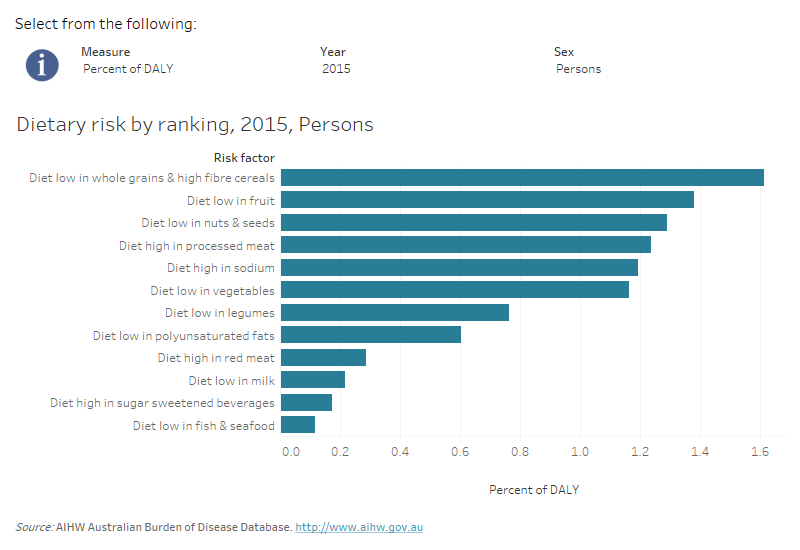Dietary risk factors
In total, 12 dietary risk factors were included in the Australian Burden of Disease Study 2015. Each dietary risk was assessed independently and included dietary components where adequate amounts in the diet are required to prevent disease, as well diets where excessive consumption contributes to disease development. Information on the recommended dietary intake can be found as part of the Australian Dietary Guidelines.
All dietary risks combined
All dietary risks were responsible for 7.3% of burden of disease in Australia in 2015.
Due to the complex relationships and interactions between risk factors, the individual dietary risks cannot be summed together. To overcome this issue a combined dietary estimate was calculated, referred to as ‘all dietary risks’.
These estimates reflect the amount of burden that could have been avoided if all people in Australia ate a healthy diet (Supplementary tables).
Individual dietary risks
The dietary risks included were a diet low in: fruit, vegetables, milk, nuts & seeds, whole grains & high fibre cereals, legumes, polyunsaturated fat and fish & seafood, as well as a diet high in: sodium, sugar sweetened beverages, red meat and processed meat.
Diet low wholegrains & high fibre cereals was the leading dietary risk contributing to 1.6% of the total burden in Australia in 2015. This was followed by diet low in fruit (1.4% of total burden in 2015), diet low in nuts & seeds (1.3%) and diet high in processed meat (1.2%).
Total burden attributable to nearly all dietary risk factors decreased between 2003 and 2015, driven largely by decreases in linked disease burden. The greatest percent decrease by a dietary risk factor between 2003 and 2015 was seen in diets low in fish & seafood (40%, 3,642 DALYs), driven by a 42% decrease due to changes in linked disease burden and a 21% decrease due to changes in exposure to low fish & seafood diets.
Diets high in red meat and diets low in milk were responsible for the only increases in total attributable burden among all dietary risk factors. Between 2003 and 2015, total burden attributable to diets high in red meat and low in milk increased by 28% (2,964 DALYs) and 4% (433 DALYs), respectively, which was driven largely by population growth.

How much disease burden does each dietary risk factor cause?
All dietary risks combined contributed 62% of coronary heart disease burden, 41% of type 2 diabetes burden, 34% of stroke burden and 22% of bowel cancer burden.
The combination of dietary risks were linked to 41 diseases. Note that the following visualisation displays the top 10 linked diseases due to dietary risks (see Supplementary tables).
How did burden attributable to dietary risks vary by age and sex?
Burden due to all dietary risks increased with age.
Males experienced a greater amount of disease burden due to all dietary risks than females in all ages up to age 84. In females, the burden due to all dietary risks was greatest in females aged 85 years and over.
Of the diseases linked to dietary risks, coronary heart disease contributed the most burden from dietary risks, followed by stroke and type 2 diabetes.
Did attributable burden vary by socioeconomic group?
Disease burden attributable to all dietary risks was twice as high in the lowest (most disadvantaged) socioeconomic group compared with the highest (least disadvantaged) group.
How has disease burden due to dietary risk factors changed over time?
The rate of total burden due to all dietary risks (from all linked diseases) decreased by 34% between 2003 and 2015 (from 19.2 DALY to 12.8 DALY per 1,000 population).


